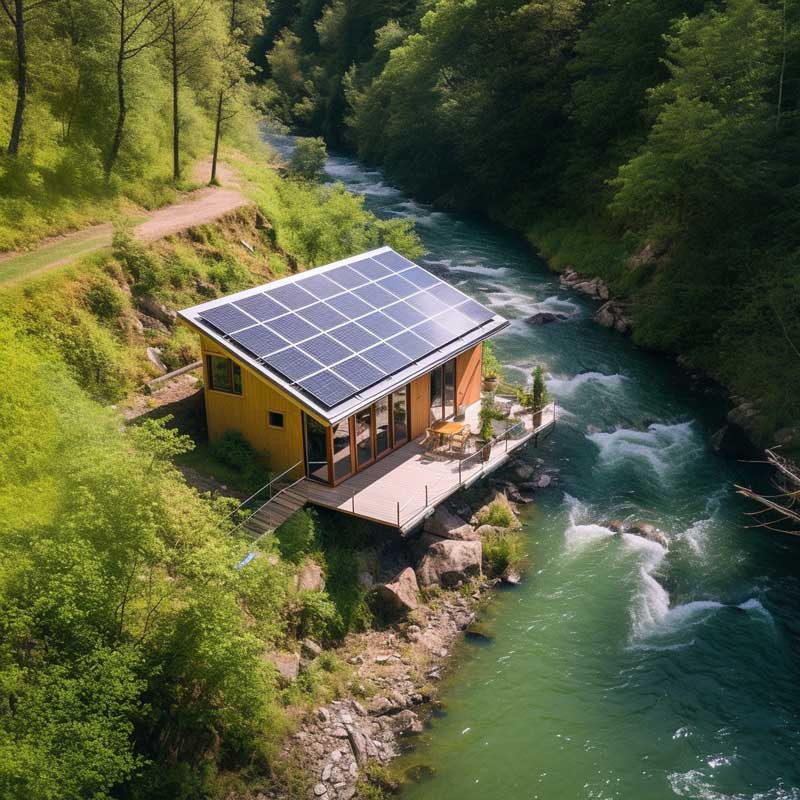
Hydroelectric Power for Home
Introduction to Home Hydroelectric Power Generation
Hydroelectric power has gained immense popularity as a reliable and eco-friendly source of renewable energy, making it an excellent choice for preppers and homesteaders. Its clean and efficient nature makes it a viable alternative to traditional energy sources. However, before setting up a hydroelectric power system, it is crucial to evaluate if your site is suitable for the purpose. This comprehensive guide will provide you with all the necessary information to assess your hydro site effectively.
What is Hydroelectric Power and can I have Hydro Power at Home?
Electricity generated through the power of falling or moving water is known as hydroelectric power. This energy is produced by converting the kinetic energy of water into electrical energy through the use of turbines. These turbines can be utilized in rivers, streams, and other bodies of water to generate hydroelectric power for homes and businesses.
Factors to Consider When Evaluating a Micro Hydro System Site
The viability of a hydropower site depends on several factors. Here are some of the most important ones:
Head and Dynamic Head
The head refers to the vertical distance from the intake or point of diversion to the hydroelectric generator. Dynamic head, on the other hand, is the net head under actual working conditions. The measurement known as the "pressure head" is always lower than the static head because it takes into account the penstock losses that occur mainly due to friction. People usually prefer to express this measurement in feet or pounds per square inch (PSI) because it is easier to conceptualize than the metric system. One PSI equals 2.31 feet of head, and one foot of head equals 0.433 PSI. One meter equals 3.28 feet.

Water Flow Rate
Flow rate refers to the volume of water that is released through the nozzles. It's just how much flowing water is going through. Leaks do not contribute to power generation. Most residential-sized systems measure the flow rate in gallons per minute (GPM), while larger hydroelectric systems typically use cubic feet per second (CFS). 450 GPM equals 1 CFS, and 1 cubic foot equals 7.48 gallons. 3.78 liters equals 1 gallon US.
Pipe Losses and Wire Transmission Losses
Sometimes, the expenses associated with purchasing pipe and wire can be excessively high and hinder the completion of a project. Pipe losses and wire transmission losses are also important factors to consider. These losses can affect the amount of power generated and the overall cost of the project.
Environmental Concerns
There can be environmental concerns when building a hydroelectric power plant. For instance, if the stream is fish-bearing, regulatory obstacles are more common, especially for larger streams. Additionally, it is important to consider the impact of the project on the surrounding environment.
Political Factors
In some cases, you may need water permits or other regulatory approvals to build a hydroelectric power plant. It is important to research and understand the political factors involved in your specific location before proceeding with your project.

Cost Considerations
Hydroelectric power is generally considered to be a cost-effective form of mechanical energy generation, with low operating costs and long lifetimes for hydroelectric power plants. However, the upfront costs of building large hydroelectric dams can be significant, and these costs may be passed on to consumers through higher electricity prices.
In addition, the costs of maintaining and repairing hydroelectric infrastructure can be high, particularly in areas where extreme weather events or natural disasters are common. Furthermore, the economics of hydroelectric power can be affected by factors such as the availability of financing, government subsidies, and changes in energy markets.
Social Considerations
The construction of large hydroelectric dams can have significant social impacts, particularly on local communities. In many cases, the construction of dams has resulted in the displacement of people from their homes and the loss of traditional lands and resources. This can lead to social conflict, as well as impacts on the cultural and spiritual practices of affected communities.
In addition, the operation of hydroelectric dams can have downstream impacts on water quality and availability, which can affect the livelihoods of people who depend on rivers for fishing, irrigation, and other uses. The benefits of generating power with a hydro-electric turbine must be balanced against these social impacts, and efforts must be made to mitigate negative effects on local communities.
Summary of Creating a Hydropower System
Hydroelectric power is a clean and renewable source of energy with relatively low environmental impacts. However, the construction and operation of large hydroelectric dams can have negative social and environmental consequences, and the costs of building and maintaining this infrastructure can be significant. As with any form of power generation, it is important to carefully consider the benefits and drawbacks of hydroelectric power and to work towards minimizing its negative impacts on people and the planet.
🔗 Related: Alternative Power products
🔗 Related: Shop alternative power
🔗 Related: Water products
🔗 Related: Shop water
🔗 Related: Shelter products
🔗 Related: Shop shelter


Leave a comment